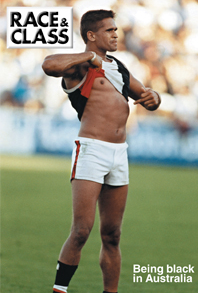Introduction to ‘Aboriginal Australia: land, law and culture’ a special issue of Race & Class edited by Peter Poynton ( 35/4, April 1994)
Australia is two societies: one multicultural, the other racist. What it presents to the world is the first and. in that, it has something to boast about – because there is no other country in the western world which has made such a success in recent years of bringing together a host of nations and peoples and cultures in a vibrant, pluralist, albeit unequal, set-up.
But, by the same token. it has failed to acknowledge the first peoples of that country and their right to their own land till now. The doctrine of terra nullius, that the land was uninhabited before the advent of the Europeans (its corollary being that the Aboriginal peoples already there were. in fact, non-human fauna) had, since colonisation began. underpinned that racism. That doctrine has now been overturned by the High Court’s ‘Mabo· decision, which, in its turn, has opened the way to land rights claims. But this was not a decision that fell from the sky: it was the result of years of campaigning and struggle over issues of land, justice, racism. Eddie Mabo, the Torres Strait Islander who spearheaded this particular legal claim to land on behalf of his people, who fought it for years through the courts, did not live to see the final judgment. He would have known, though, that its implications would spread far beyond the Mabo case itself.
Some of those implications are only now becoming apparent, as this special issue of Race & Class makes clear. For, as Noel Pearson demonstrates in his evocative reflections on the present situation of Aboriginal Australia, “A troubling inheritance’, Aboriginal customary law is now a source for Australian common law. Mabo itself directly affects only a very small section of the Aboriginal population and, although in some parts of Australia large amounts of land, semi-arid and not commercially developed, can be handed over to Aboriginal people, particularly in Western Australia, in the eastern states which were colonised earlier (New South Wales, Victoria) only small amounts of land will be claimable. But the reaction against Mabo from right wing politicians. the media and mining interests has been hysterical, fierce and prolonged, as Peter Poynton so brilliantly argues in ‘Mabo: now you see it, now you don’t!’.
Mabo has, too, brought Australian common law into line with international law and, as H.A. Amankwah points out in ‘Mabo and international law’, this brings in its train a whole series of obligations on the Australian Commonwealth in terms of indigenous self determination. The argument is carried further, into the political fight that will be necessary for such obligations to be realised, by Mick Dodson in ‘Towards the exercise of indigenous rights: policy, power and self-determination’. Indeed, self-determination is a direction that a number of communities are already moving in – despite the efforts of ATSIC, hitherto the ‘Aboriginal’ face of government, to control them, outlined by Paul Coe in ‘ATSIC: self-determination or otherwise’. Getano Lui Jnr in ‘Torres Strait: towards 2001’ shows how the Torres Strait Islanders are attempting to take control of their own region, safeguarding its fragile environment and organising their own resources. He calls for a new constitutional arrangement. And Peter Yu, in a trenchant analysis of the devastation inflicted on Aboriginal communities in the Kimberley (‘The Kimberley: from welfare colonialism to self-determination’) similarly calls for the control of those resources to be vested in the communities themselves.
No such achievement would be feasible, however, without the ongoing dynamism and resilience of Aboriginal culture, whether urban or traditional, historical or contemporary. One of those who did most, as an individual and as a representative of her people, to unite political and cultural issues in a never-ending fight for justice, was the late Oodgeroo Noonuccal, whom I had the good fortune to meet at the World Council of Churches Consultation on Racism in London, in 1969, and whose death was mourned across her continent and a few others. Her life-work is here recreated for us by John Collins, her publisher for twenty years, in ‘Oodgeroo of the tribe Noonuccal’.
The richness and significance of that culture can only be sampled here. In ‘Aboriginal art and film: the politics of representation’, Marcia Langton carves out a black aesthetic of Aboriginal culture. John Scott, in his ‘Black theatre: does “sold out” mean ‘”selling out”?’, poses, simply and compellingly, the dilemmas that confront black art before a white audience. Mandawuy Yunupingu, musician and educator, shows, in his limpid ‘Yothu Yindi: finding balance’, one form of resolution, based in traditional experience and speaking to con temporary issues.
Needless to say, this issue could not have been put together but for the unstinting efforts of Peter Poynton, and the generous practical and technical assistance afforded him by the Tharpuntoo Legal Service, Cairns, and its administrator, Bronwyn Villaflor. And thanks. too, to Dany Celermajer and all those organisations and individuals who responded at very short notice to our requests for articles.

